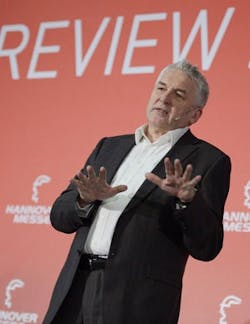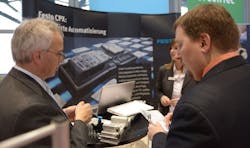Hannover Fair and Promises of Integrated Industry
This week in Hannover, Germany, Deutsche Messe is giving a bit of a preview of the Hannover Fair, which takes place April 8-12. They've invited the press to come out and see 46 exhibitors, whose representatives have brought just a smattering of what they plan to show a couple months from now. It's just a small taste of the more than 6,000 exhibitors expected for this year's show.
The theme this year is "Integrated Industry," and it's interesting to see what people make of that. The keynote speaker for today's event, Manfred Broy, a professor of software and system engineering at TU Munich, described integrated industry in terms of cyber-physical systems - exchanging data between the physical world and devices to make the Internet "real-world aware." He talked of the shift from today's smart embedded systems to the cyber-physical systems of tomorrow, where devices - smartphones to traffic lights, airplanes to buildings - become embedded software systems linked directly to the Internet.
Broy’s example is within the automotive industry, where 40% of the cost of a typical car is attributed to electronics and software. There are 100 million lines of code in a car—compared with only 50-70 million lines of code in a space shuttle. “The airbag in a car would be unthinkable without software systems,” Broy says.
The integration of the future that Broy speaks of comes in part through the potential for data mining. “Each vehicle has a huge number of sensors,” he says. “If the information could be provided to the Internet at the right time, then there are huge opportunities.”
There could be opportunities in traffic control measures, for example, and it paves the way for autonomous vehicles. “Within the next 10-15 years, autonomous vehicles will be able to navigate their way through normal traffic,” Broy says. Never mind being able to read the morning paper while your car does the driving. The real attraction, he insists, comes through innovations like car sharing, in which the car could drive itself to the person who needs it next.
While some of the ideas Broy spoke of sound pretty futuristic, the technology is being used now to a large degree. And there are examples within industry as well. Integrated industry is an overarching trend that includes integrated intelligence, safety and security aspects and energy efficiency, noted Eberhard Klotz, head of marketing of products and technology for Festo. He points to the huge amount of data being collected in factories, and the higher degree of decentralized intelligence. “It will be much more important in the future,” he says.
Festo, one of the exhibitors taking part in the preview, was showing off an integrated pneumatics control system with embedded intelligence. A CoDeSys-based controller can be embedded, and for a relatively small system with about 500-1,000 I/O points, it can handle the full control.
Klotz told me about their self-adjusting servo pneumatics system that makes use of some of the integrated technology that Broy spoke of to make more self-aware systems.
Because air is compressible, it’s difficult to regulate position in a pneumatics system, particularly if a load is changed, Klotz explained. But Festo’s system uses the speed and acceleration to detect that the load must have changed. The closed-loop system adjusts automatically, adapting to any environment changes. It adjusts not only based on precise position location, but also based on how much time it took to get there. “So if, just as an example, it took 3 s to get into position the first time, it will get there 0.3 s the next time,” Klotz said.
Festo is the company that came out a couple years ago with the SmartBird and other bionic creations. The SmartBird can start, fly and land completely autonomously. Its wings beat up and down and also twist at specific angles. Although she refused to give any specific details, Festo’s Simone Schmid says that we can expect to see a new bionic creation with even more astounding flight capabilities at this year’s Hannover Fair.
Aaron Hand is the managing editor for Control Design and for Industrial Networking. Email him at [email protected] or check out his Google+ profile.



